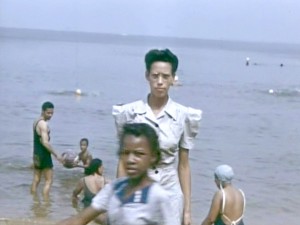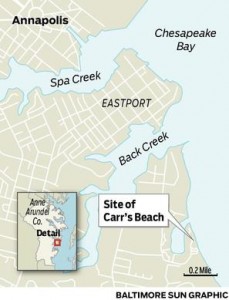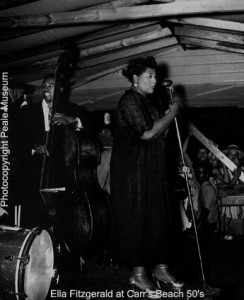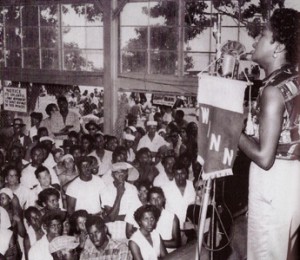Destination was popular resort during era of segregation
By Mary Gail Hare (The Baltimore Sun, October 13, 2011)
Decades ago, a trip to segregated Ocean City presented far too many challenges for African-American families. Instead they went to a sandy peninsula near Annapolis, known as “the beach,” for a day’s outing.
Carr’s Beach — its proper name — offered swimming, picnics and entertainment. Many recall performances by up-and-coming stars such as Louis Armstrong, James Brown and Ray Charles, who, while touring on the Chitlin’ Circuit, stopped at Carr’s, one of the few local venues open to black entertainers of that time.
“I remember it was the closest we could get to the water,” said Delores McIntyre, 79, a lifelong city resident. “The water was so clear and there was great entertainment, especially Ray Charles.”
*** More on Carr’s Beach ***
“Remembering Al Brown (1929-2009)“
In an article celebrating the life of Baltimore musician Al Brown (“The Madison”), the August-September-October 2009 issue of the Blues Art Journal referenced Brown’s gigs with his band the Tunetoppers at Carr’s Beach, where stars like Ella Fitzgerald and Sarah Vaughan also performed:
Locally, aside from the Royal Theatre, there was also another uniquely summertime venue considered as part of the national “Chitlin’ Circuit,” Carr’s Beach in Anne Arundel County. Located at the mouth of the Severn River off Edgewood Road on the peninsula across Back Creek from Annapolis’ Eastport district, Carr’s Beach was home of the concert series “Bandstand on the Beach,” which was hosted live over WANN-AM (one of the first stations in the U.S with a black oriented format) by legendary disk jockey, Hoppy Adams. Moreover, the site (now the Villages of Chesapeake Harbour condominiums), a blacks only, 20 acre resort and amusement park, had an open air dance pavilion which could accommodate several hundred people. Although this sprawling complex was owned by a consortium of Afro-American businessmen in Baltimore, it was overseen by the late producer (Ru-Jac records), Rufus Mitchell, who was longtime a major mover and shaker in the Baltimore music scene. “Yeah, we appeared a few times at Carr’s Beach, especially after our hit record, but we had our own favorite Sunday afternoon spot and built in fan base for years at Beachwood Park. It was run by a Reverend Smith and down the same neck of the woods [in Pasadena on the Magothy River]. What I remember most, though, is coming home and being stuck in traffic on [Governor] Ritchie Highway and wondering if we were ever going to make our Sunday night gig,” said Charles with a chuckle. (Larry Benicewiz, Baltimore Blues Society)
Gone But Not Forgotten
This popular and often requested Maryland Public Television documentary, narrated by columnist Dan Rodricks, takes a nostalgic look back at places in the Maryland region that are physically “gone but not forgotten” in memory.
A segment on Carr’s Beach is included, as well as Baltimore’s Hippodrome Theatre, Baltimore’s streetcars, Carr’s Beach in Annapolis, White Tower Restaurants, Royal Theatre, Pimlico Hotel, Gwynn Oak and Carlin Amusement Parks. (Maryland Public Television, original production 1994, 60 minutes)
MPT sells this DVD for $50 dollars.
Audiovisual Links:
Watch a clip from Caldwell McMillan’s Carr’s Beach film. (Courtesy Baltimore Sun)
Listen to this 1966 Carr’s Beach commercial set to a vintage photo montage.
Related Links:
Carr’s Beach.com





I’m responding to the Beachwood Park listing. I have fond memories of Beachwood Park and Rev Hiram Smith Sr, Pastor, Mt. Lebanon Baptist Church, located on Reisterstown Rd, Baltimore City. As a good friend of Rev Smith’s son Lionel, I spent many enjoyable summers at their summer home on the Magothy River adjacent to Beachwood Park . During the summer months, Mt Lebanon Baptist church members would enjoy the beach and many amusement rides, and picnics. Rev Smith hosted boat rides to all on his yacht. I later discovered Anne Arundel covenant laws in the 1940’s and early 50’s prohibited African Americans from owning properties such as Beachwood Park. Being the ever resourceful person, Rev Smith purchased the property under the name of a very good Jewish friend. Years later, after these laws were repealed
he acquired rightful legal ownership of the property. Beachwood Park will forever remain in my thoughts as a wonderful place for families to enjoy, thanks to Rev Hiram Smith, Sr.
I remember CARR`S BEACH as a lil boy,this was the family`s Vacation spot in the summer,we always made trips to the beach with about 3 to 4 car loads,I saw JACKIE WILSON,just one of the acts I saw back in the 60`s,I also liked the rides there and that concessions house where it had games,food and other things you could do there,I loved it,loved going to CARR`S BEACH.
Yes! Thanks for the memories. I remember an unforgettable performance by the great Otis Redding at Carr’s Beach in the 60s.
Oh…how I remember both Carrs and Sparrows beaches. Such good memories with my family. Most have gone home to be with the Lord but those memories are forever in my head and buried deep in my heart.
My two sisters and I were a trio. DJ “Hot Rod” (Marice Holbert, 3rd) was our manager. We performed at Carr’s Beach, as background singers for James Brown.